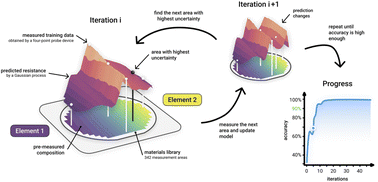博文
自主测量仪器专门寻找新材料
||
自主测量仪器专门寻找新材料
诸平
据德国波鸿鲁尔大学 (Ruhr University Bochum) 2023年10月30日提供的消息,自主测量仪器专门寻找新材料(Autonomous measuring instruments specifically find new materials)。新算法挖掘材料库的速度比以前快四倍,它是以机器学习为基础的。上述图片是费利克斯·特伦(Felix Thelen)正在波鸿鲁尔大学新材料与界面系主任撰写其博士论文。
研究人员正在全力寻找能源转型所依赖的未来技术的新材料,例如电催化剂(electrocatalysts)。由于其多功能特性,由五种或更多元素组成的材料特别令人感兴趣。元素周期表中约有50种可用元素,因此可能的材料数量几乎是无限的。由阿尔弗雷德·路德维格(Alfred Ludwig)领导的波鸿鲁尔大学材料研究所材料发现和界面主任(Chair for Materials Discovery and Interfaces, Institute for Materials, Ruhr University Bochum, Universitätsstraße, Bochum, Germany)费利克斯·特伦开发了一种算法,可以比以前快四倍地研究候选材料。这是机器学习的一个子领域——是通过主动学习的概念使之成为可能。研究团队于2023年9月19日已经在《数字发现》(Digital Discovery)杂志网站发表了相关研究结果——Felix Thelen, Lars Banko, Rico Zehl, Sabrina Baha, Alfred Ludwig. Speeding up high-throughput characterization of materials libraries by active learning: autonomous electrical resistance measurements. Digital Discovery,2023,2(5): 1612-1619. DOI:10.1039/D3DD00125C. First published 19 Sep 2023. https://doi.org/10.1039/D3DD00125C.
测量样品需要几天或几周的时间(Days or weeks to measure a sample)
尽管高度专业化的方法可以在单个样品上并行生产一系列材料,然后自动测量它们,但在分析中每一分钟都很重要 - 因为在样品检查完成之前可能需要几天或几周的时间。新算法可以集成到现有的测量仪器中,并可以将其效率提高很多倍。
测量仪自行搜索测量点(Measuring instrument searches for measuring points itself)
“通过使用主动学习(Active Learning),测量仪器能够根据现有的材料信息独立选择样品上的下一个测量点。”自主测量程序的开发人员费利克斯·特伦解释道。关于测量的材料特性的数学模型,直到足够的精度为止,然后可以停止测量-并通过生成的模型来预测剩余测量点的结果。
费利克斯·特伦说:“波鸿鲁尔大学研究团队能够使用十个研究材料库的电阻测量示例来证明该算法的功能。我们真正的工作才刚刚开始,因为在材料研究中,有比电阻测量复杂得多的测量方法,也需要优化。现在必须与仪器制造商合作开发能够集成此类主动学习算法的解决方案。”对具有以前未使用的特性的材料进行有针对性的设计应该能够实现新的应用。
这项工作得到墨卡托基金会(Mercator Foundation)、墨库尔项目(Mercur Project DIMENSION Ex-2021-0034)、中小企业创新中心项目(Zentrales Innovationsprogramm Mittelstand简称ZIM: KK5380601ZG1)、德国研究基金会(Deutsche Forschungsgemeinschaft简称DFG / German Research Foundation)项目(DFG Project 190389738; DFG Project LU1175/31-1)的支持或资助。
上述介绍,仅供参考。欲了解更多信息,敬请注意浏览原文或者相关报道。
High-throughput experimentation enables efficient search space exploration for the discovery and optimization of new materials. However, large search spaces, e.g. of compositionally complex materials, require decreasing characterization times significantly. Here, an autonomous measurement algorithm was developed, which leverages active learning with a Gaussian process model capable of iteratively scanning a materials library based on the highest uncertainty. The algorithm is applied to a four-point probe electrical resistance measurement device, frequently used to obtain indications for regions of interest in materials libraries. Ten libraries with different complexities of composition and property trends are analyzed to validate the model. By stopping the process before the entire library is characterized and predicting the remaining areas, the measurement efficiency can be improved drastically. As robustness is essential for autonomous measurements, intrinsic outlier handling is built into the model and a dynamic stopping criterion based on the mean predicted covariance is proposed. A measurement time reduction of about 70–90% was observed while still ensuring an accuracy above 90%.
https://wap.sciencenet.cn/blog-212210-1407929.html
上一篇:科学家开发了一种新方法来制造稳定、高效的下一代太阳能电池
下一篇:马蒂亚斯·曼多弗荣获欧洲联合胃肠病学新星奖

